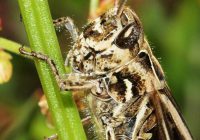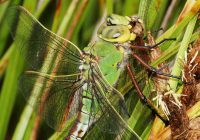Dr Phil Smith’s Wildlife Notes
July 2012
Continuing rainfall during the month prompted comparisons with 2007 for the wettest summer on record. It certainly had dramatic effects on the Sefton duneland with re-flooding of many slacks that are normally bone dry at this season. Large sections of Birkdale Green Beach were so deep that my Wellington boots were in danger of being swamped. Late spawning by Natterjack Toads resulted in toadlets emerging in several places but will they have enough time to fatten up before hibernation?
Sand-dune plantlife also responded to the cool damp conditions with spectacular flowering of many species, ranging from rare orchids to Common Ragwort, though most appeared a week or two later than usual. During a walk through the floristic abundance of Ravenmeols dunes, a friend was heard to mutter “You couldn’t grow a garden like this!” That day (22nd) we also counted 22 Dark Green Fritillaries and saw the first Graylings of the summer. Indeed many of our butterflies and day-flying moths seem to have done surprisingly well. Thus, early in the month, Narrow-bordered Five-spot Burnets provided their best ever display at Hightown, nectaring on colourful swathes of Viper’s Bugloss. The related Six-spot Burnets, always a little later, first appeared in mid-month, soon becoming equally abundant. These striking red-and-black moths are protected from predators by cyanide absorbed by the caterpillars from their main food-plant, Bird’s-foot-trefoil.
Trevor Davenport joined me on 15th for a visit to Ainsdale National Nature Reserve to survey the Forester moth. Last year, a sizeable colony of this regional notable species was located on a meadow close to the reserve entrance. We soon found them, eventually reaching a total of 17 of these iridescent Lincoln-green insects. The importance of Common Ragwort as a nectar source was reinforced, most of them being found on this flower. However, the highlight of the day was a White-letter Hairstreak, also on Ragwort, close to a row of Elms, its only food-plant. This is a particularly elusive butterfly and it was the first I had seen locally in 44 years of field recording! The following week, Trevor spotted two more, one unfortunately dead in a spider’s web, so there must be a small colony there. The same site produced dozens of Small Coppers, Gatekeepers, Meadow Browns and Small Skippers , together with enormous numbers of all three of our sand-dune grasshopper species, the Field, Common Green and Mottled.
Sun-loving dragonflies were less in evidence than usual but as Red-veined Darters were reportedat Seaforth Nature Reserve on 8th, a visit the following day was a must. Sure enough, two males of this long-distance migrant from Europe were still there, though too wary to photograph. I had better luck with a female Emperor which posed while consuming an unlucky Common Dater. Nearby, were over 150 flower-spikes of Southern Marsh Orchid, many of enormous stature. The tallest, measured at 90cm, was by far the largest I have ever seen.
A rare trip inland on 14th saw me leading the annual dragonfly walk at Mere Sands Wood Nature Reserve, one of Lancashire’s premier locations for these insects. There was a good turn-out and, despite far from ideal weather, we managed to find nine species, including Emperor, Black-tailed Skimmer and Emerald Damselfly.
In the June notes, I mention our monitoring of last year’s Isle of Man Cabbage translocation from the Crosby dunes, including the unexpected recovery of the original colony whose sand-dune habitat had been trucked to Hightown for use in coast defence. On 23rd, Patricia Lockwood joined me to see whether any plants had survived the journey to Hightown. We were amazed and delighted to find about 230 Isle of Man Cabbage plants, mostly seedlings, on the sand-bund south of the Sailing Club. They must have germinated from seeds in the sand brought from Crosby. With any luck, these plants should produce a new colony of this nationally scarce endemic.




